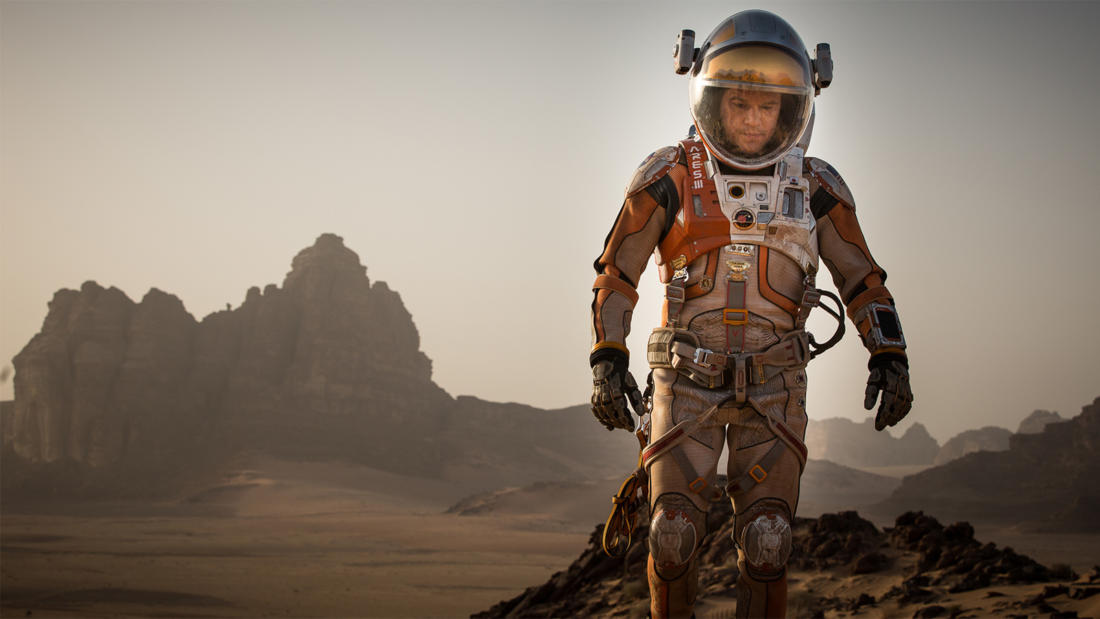
Media Arts Center: Digital Gym Cinema San Diego, CA
Dr. Jane K. Willenbring
Associate Professor, Geosciences Research Division at Scripps Institution of Oceanography, University of California, San Diego
andDr. Dave Stegman
Associate Professor, Institute of Geophysics and Planetary Physics at Scripps Institution of Oceanography, University of California, San Diego
The Martian— Bring him home...or not?
Program Description
A talk on growing food and exploring on a hostile planet.
Presented At
Media Arts Center: Digital Gym Cinema San Diego, CA
Film Synopsis
When astronauts mistakenly leave Mark Watney behind on Mars, the stranded visitor must use his wits, spirit, and scientific know-how to find a way to survive on the hostile planet.
During a manned mission to Mars, Astronaut Mark Watney (Matt Damon) is presumed dead after a fierce storm and left behind by his crew. But Watney has survived and finds himself stranded and alone on the hostile planet. With only meager supplies, he must draw upon his ingenuity, wit, and spirit to subsist and find a way to signal to Earth that he is alive. Millions of miles away, NASA and a team of international scientists work tirelessly to bring "the Martian" home, while his crewmates concurrently plot a daring, if not impossible, rescue mission. As these stories of incredible bravery unfold, the world comes together to root for Watney's safe return. Based on the best-selling novel by Andy Weir, and helmed by master director Ridley Scott, The Martian was nominated for three Golden Globes.
About the Speaker
Dr. Jane Willenbring is an associate professor in the Geosciences Research Division at Scripps Institution of Oceanography at the University of California, San Diego. She joined Scripps in summer of 2016, and currently serves as the director of the Scripps Cosmogenic Isotope Laboratory (SCI-Lab). Dr. Willenbring is a geologist who solves problems related to the Earth surface. Her research is primarily done to understand the evolution of the Earth’s surface, especially how landscapes are affected by tectonics, climate change, and life. She and her research group use geochemical techniques, high-resolution topographic data, field observations, and, when possible, couple these data to landscape evolution numerical models and ice sheet models. The geochemical tools she uses and develops often include cosmogenic nuclide systems, which provide powerful, novel methods to constrain rates of erosion and mineral weathering. She has also started to organize citizen science campaigns and apply basic science principles to problems of human health with an ultimate broader impact goal of cleaning up urban areas and environments impacted by agriculture.
Dr. Willenbring received her BSc with honors from the North Dakota State University, a master's degree from Boston University and her PhD in Earth sciences from Dalhousie University in Halifax, Nova Scotia Canada. She was a Synthesis Postdoctoral Fellow through the National Center for Earth Surface Dynamics at the famous Saint Anthony Falls Lab at the University of Minnesota, and an Alexander von Humboldt Postdoctoral Fellow and then subsequently a Postdoctoral Researcher at the Helmholz GFZ Potsdam, Germany. She was previously a professor at the University of Pennsylvania.
Dr. Dave Stegman is an associate professor of geophysics in the Cecil H. and Ida M. Green Institute of Geophysics and Planetary Physics at Scripps Institution of Oceanography at the University of California, San Diego.
Dr. Stegman uses high-performance computing and advanced four-dimensional visualization systems to explore the intricate details of how planets evolve and why plate tectonics are unique to Earth.
His current research investigates global scale dynamics by reconstructing the history of where tectonic plates have been recycled into the earth’s mantle over the past 300 million years. This research aims to address many of the most important geodynamic events over the past 200 million years, including a 35 million year phase during the Cretaceous period when the magnetic field stopped reversing, increased production of volcanic greenhouse gases led to a warmer climate and several planetary reorientations of the entire solid Earth, known as true polar wander, occurred.
Prior to joining Scripps, he was the Centenary Research Fellow at the University of Melbourne, and previous to that was at Monash University where he was an Australian Research Council Postdoctoral Fellow. During his time in Australia, he pioneered 3D numerical models of free subduction, which address questions of why tectonic plates move, how plate boundaries evolve, and how features in the Earth's deep interior develop. This effort aims towards simulating regional tectonic evolution and providing a nucleus for integrating geological and geophysical data sets.
Dr. Stegman received his PhD from the University of California at Berkeley, where he developed one of the first three-dimensional spherical models of thermo-chemical convection to investigate the thermal evolution of Earth, the Moon, and Mars with an emphasis on the important role of chemically distinct materials. Renewed interest in this area of planetary geodynamics led to a new model for explaining many of the enigmatic features on Enceladus, an icy moon of Saturn.